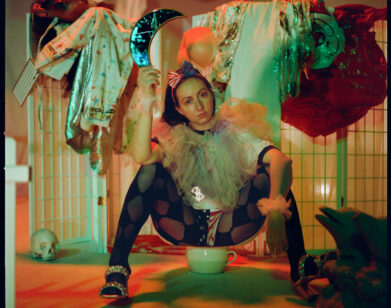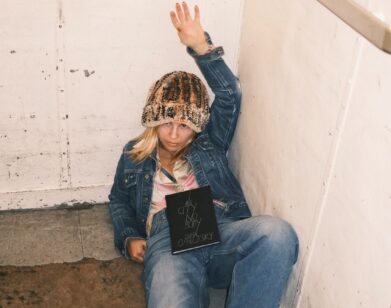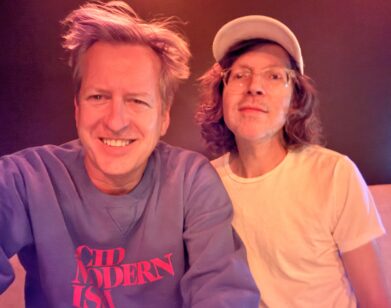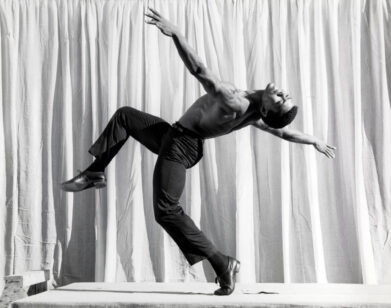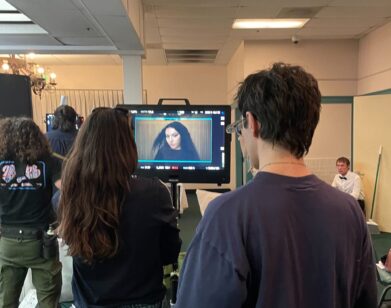Mickalene Thomas on Muses, Models, and Mentors
MICKALENE THOMAS IN HER STUDIO, BROOKLYN, NEW YORK, FEBRUARY 2016. PORTRAITS: CHRISTIAN HOGSTEDT.
Brooklyn-based artist Mickalene Thomas is known for her large-scale, rhinestone-encrusted, highly stylized collaged portraits of everyday black women, whom she calls her muses. However, in a new solo show entitled “Mickalene Thomas: Mentors, Muses, and Celebrities,” opening today at the Aspen Art Museum, Thomas turns to black celebrity women found in films and on the stage to explore the relationships of black sisterhood.
“The inspiration behind the show is mainly love,” Thomas says. “I was thinking of how, as a woman of color, I have developed to be the woman that I am and how I see myself in others.” She then adds, “We look at each other in this sisterhood way and it defines who we are—our sense of confidence, our sense of worth.”
When she began thinking of images and films that portray women of color, Steven Spielberg’s 1985 adaptation of Alice Walker’s novel The Color Purple immediately came to mind. For Thomas, the complicated and liberating portrayal of a forged sisterhood, found in both the film and book, between Ms. Celie and Shug Avery reflects an enduring story about black women everywhere. It’s a relationship that depicts sexuality, femininity, and power—all of which are themes consistently found in the artist’s photography and painting.
For the collage painting Sister: Shug Avery’s Breakfast, Thomas extracts an image from the film of Ms. Celie, played by Whoopi Goldberg, during the scene in which Celie sits, hands resting on her face, watching as her husband attempts to make his mistress, Shug Avery, breakfast. “I was interested in making the audience see these women not just as characters, but as signifiers,” Thomas explains. In the exhibition, she continues, “they are no longer characters, but representations of women throughout different generations.”
Further inspiration for the new video and film works on view was gathered from an Eartha Kitt performance of Angelitos Negros, or, Little Black Angels (1948). Dressed in all black against a white backdrop, staring into a camera as tears slide down her face, Kitt sings in a way that questions both the cannon of history and representation: “How don’t you paint our skin if you put love in your art?”
“Eartha Kitt is passionately singing and speaking about the lack of positive black images in the world,” explains Thomas, who had her first solo museum exhibition at the Brooklyn Museum in 2012. “I was sort of like, ‘This song is everything!’ It’s so timely and it says everything that I am trying to say. I’m putting these black angels out there—I’m doing it.”
Last month, as she was putting the finishing touches on the artworks now in Aspen, we met with the artist in her Brooklyn studio.
ANTWAUN SARGENT: In what ways do you think The Color Purple embodies the relationships you explore in this exhibition?
MICKALENE THOMAS: I started reading The Color Purple again and thinking about what scenes were very profound and represented pivotal moments where the characters really transformed. For me, that was the relationship between Celie and Shug Avery—how Celie saw the potential of herself through someone else and how that relationship gave her strength, how she learned of her own beauty by Shug holding a mirror up to her face and saying, “Look at yourself and understand your beauty.” Then this love affair developed between the two, a love affair of two women who admired each other for their differences, strengths, creativity, and talent. They persevered in their own way. What Shug did for Celie, Celie did for Shug in a whole different way.
SARGENT: So the collaged portraits in the exhibition function as mirrors of womanhood?
THOMAS: Yes, I’m using these scenes by abstracting them from the film and claiming and presenting them as these mirror images of who we are and how we related one another. In Ms. Celie’s Blues, I show the moment when they are at the club and Shug is singing to Celie, and she is siting at the table like a little girl feeling lost and out of place. Then suddenly the room parts because Shug is focused on her and she is saying, basically, “You are everything.” For me, that moment goes toward philosophies like [Jacques] Lacan’s notions of beauty, which basically says we don’t necessarily see ourselves until we look into a mirror; we can be those mirrors when we see ourselves in each other and have a sense of validation.
SARGENT: In what ways do Celie and Shug hold that mirror up to you?
THOMAS: I can understand their relationship. I can relate to both of these women for different reasons. I’ve seen myself in different aspects of my life as a Celie, where my sense of self becomes insecure in some ways, like growing up, not feeling as beautiful as most people, and how my levels of desires were prevented by how people related to me.
SARGENT: In what other women do you find the relationship that Celie and Shug Avery shared?
THOMAS: In the film Singers and Comedians that I am showing, there are comedians and singers that range from Moms Mabley, Josephine Baker, Nina Simone, Whitney Houston, and Eartha Kitt to Whoopi Goldberg herself—all women who I grew up with and was inspired by because of my mother and grandmother. In the film, I am projecting two channel screens, where on one side it’s the comedians and on the other side it’s the signers. They are connected in the sense of their lyrics and sound. It’s not a cacophony of sound; we exacted their lyrics and lines, and together the thread of the music and the jokes tell this story of being a black woman. It’s sort of like, who is a black woman? What is a black woman? The film ends with Eartha Kitt asking, “Why aren’t there any black angels?”
SARGENT: You also use laughter in Comedians and Singers as an expression of black womanhood.
THOMAS: That’s what I love. They use the language of laughter, which is sort of a male dominated platform, to share their lives. I remember when I first saw Whoopi Goldberg doing standup and she was wearing a sheet on her head, basically pretending to be this little white girl with long luxurious blonde hair. Everyone can relate to that. It’s an oral history of black women’s lives through laughter. Yeah, it was funny, but it was also horrific because that’s how we define beauty.
SARGENT: Do you see telling a story of being a black woman as one of your roles as an artist?
THOMAS: I hope, yeah. I actually didn’t see that as one of my roles until it was pointed out to me by Carrie Mae Weems. She and I had a conversation, and she was like, “Mickalene, I really think you need to recognize what you are doing. You need to own it.” I knew what I was doing, but I never really considered the magnitude of how my images were transformative to people.
SARGENT: If had to explain it, what do you think your images have done in the world?
THOMAS: I think what I have done is claimed the space and pushed it forward as much as I can in relationship to who I am and how I live my life. I have used my opportunity to allow these images to be seen. It’s like what Beyoncé is doing with Formation: She has a major platform and I am giving her high fives and saying, “Yes, we have been needing you to do this for a long time.” So that’s what I am doing. I am saying, “Here’s this opportunity to see women differently.”
SARGENT: How is the series of the screen tests of your muses different than Singers and Comedians?
THOMAS: The women in the screen tests are the women I generally work with, but they are not posing for one of my photo shoots. They are natural, they’ve come as they are, and they are just sitting in the space looking into the camera.
SARGENT: Did you learn something new about your muses in letting them be without direction?
THOMAS: It depends on the woman. With some of them I learned that they felt the need to portray someone when they were in their natural form. With others, when they were dressed up, they became more of themselves. It’s like they see themselves in the lens, and the lens becomes the mirror, and for me that is very beautiful. I grew up with a lot of brothers and I don’t have any sisters, so for me it’s really important to develop my sisterhood. It’s something I’ve always coveted.
SARGENT: There’s a video of you nude as an Odalisque…
THOMAS: That’s about black feminism and vulnerability and me giving you everything. Here I am, the artist, the person, the black woman, and the stereotype. I’m using myself and it has nothing to do with my muses or other women. It has to do with me. You see parts of my body moving, very collage like, flashing, and not speaking, just laying on a couch, looking out at the viewer.
SARGENT: What attracted you to video for this show?
THOMAS: This show allowed me to think about video and film as a tool of expression for portraiture. I got really excited about finding new ways of using video, and the immediacy is different, in a way, than painting and photography. The creativity comes with the editing. You can layer and cut and paste. I really love that it’s like another form of making my smaller collages but in video form.
SARGENT: The grid format used throughout the films and videos seem to also continue your exploration of collage.
THOMAS: I’m using the grid as formation. I wanted a relationship between the paintings and videos so that way when you are looking at the videos there’s a direct relationship to the paintings. I think in grids there’s a multiplicity of many parts that make up a whole. Things can be moved around, they are not fixed, there’s still a notion of collage—the painting is collaged together. It’s about constructing the image.
For me, these works are meant for the viewer to sit and be with—not just walk in and out. The sound and lyrics are all metaphors of messages, the visuals are another layer, the intimacy of being in the space is an added layer, and the two-dimensional objects are yet another layer. So you are able to be consumed by the space and be with the women and try to ascertain these relationships.
“MICKALENE THOMAS: MENTORS, MUSES, AND CELEBRITIES” OPENS TODAY AT THE ASPEN ART MUSEUM AND WILL BE ON VIEW THROUGH JUNE 12, 2016. FOR MORE ON THE ARTIST, VISIT HER WEBSITE.



